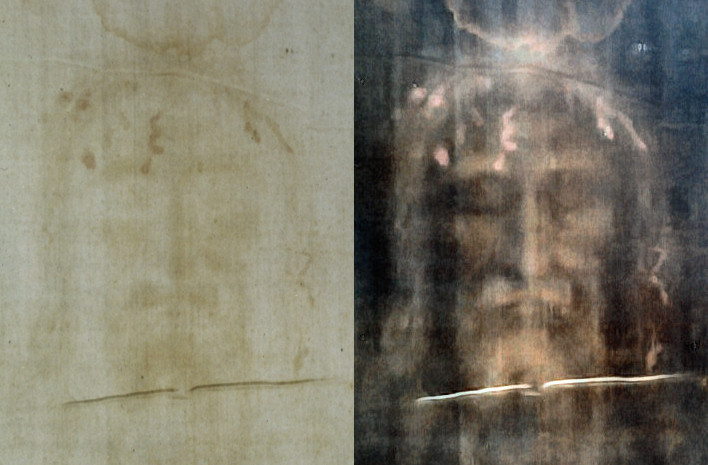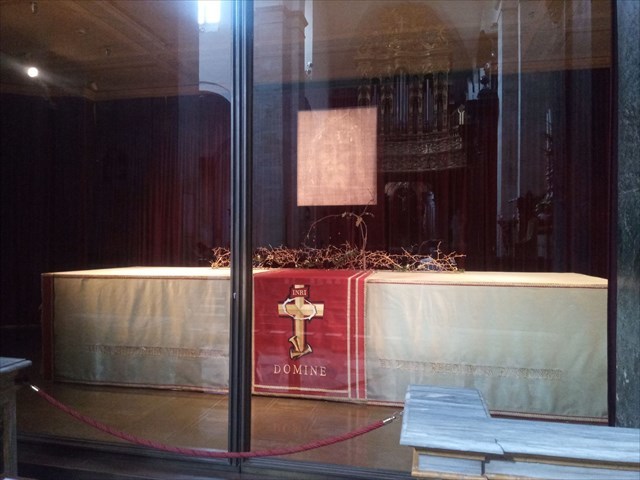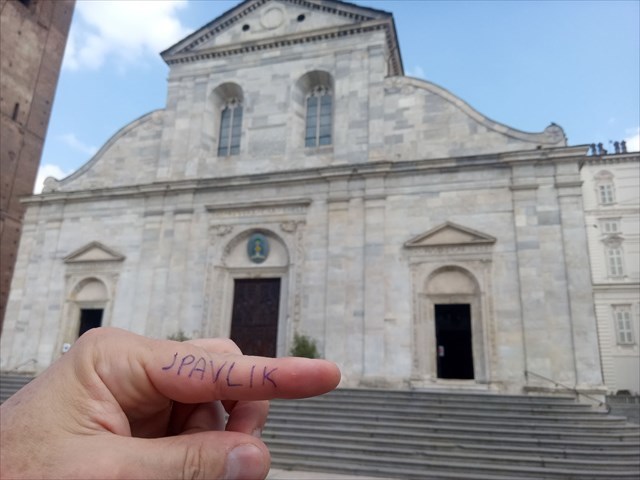🇮🇹
La Sindone di Torino, nota anche come Sacra Sindone o Santa Sindone, è un lenzuolo di lino conservato nel Duomo di Torino, sul quale è visibile l'immagine di un uomo che porta segni interpretati come dovuti a maltrattamenti e torture compatibili con quelli descritti nella passione di Gesù. Alcune persone identificano l'uomo con Gesù e il lenzuolo con quello usato per avvolgerne il corpo nel sepolcro.

Il termine "sindone" deriva dal greco σινδών (sindon), che indicava un ampio tessuto, come un lenzuolo, e che se specificato poteva essere di lino di buona qualità o tessuto d'India. Anticamente il termine "sindone" era generico e non collegato alla sepoltura, ma oggi il termine è ormai diventato sinonimo del lenzuolo funebre di Gesù.
Nel 1988, l'esame del carbonio 14 sulla Sindone, eseguito contemporaneamente e indipendentemente dai laboratori di Oxford, Tucson e Zurigo, ha datato la sindone in un intervallo di tempo compreso tra il 1260 e il 1390, periodo corrispondente all'inizio della storia della Sindone certamente documentata. Ciononostante, la sua autenticità continua a essere propugnata da una serie di autori.
Le esposizioni pubbliche della Sindone sono chiamate ostensioni (dal latino ostendere, "mostrare"). Le ultime sono state nel 1978, 1998, 2000, 2010, 2013 (quest'ultima soltanto televisiva), dal 19 aprile al 24 giugno 2015 e l'11 aprile 2020 (anche quest'ultima solo televisiva, in occasione del sabato santo occorso durante la pandemia di COVID-19.
La Sindone e' chiusa in una scatola ignifuga posta nel Duomo in una delle cappelle laterali.

Il contenitore con la sindone
Requisiti per loggare
Fare un selfie davanti il duomo. Chi non vuole fotografare la propria faccia puo' fare una foto della facciata del duomo insieme con un bigliettino con il proprio nick o l'icona del profilo. Va bene anche un coin personale.

Esempio della foto per il log
🇬🇧
The Shroud of Turin, also called the Turin Shroud (Italian: Sindone di Torino, Sacra Sindone [ˈsaːkra ˈsindone] or Santa Sindone), is a length of linen cloth bearing the negative image of a man. Some claim the image depicts Jesus of Nazareth and the fabric is the burial shroud in which he was wrapped after crucifixion. The existence of the shroud was first securely attested in 1390 when a local bishop wrote that an unnamed artist had confessed that it was a forgery. Radiocarbon dating of a sample of the fabric is consistent with this date of origin.
The artifact is kept in the Cathedral of Turin, which is located next to a complex of buildings composed of the Royal Palace of Turin, the Chapel of the Holy Shroud (located inside the Royal Palace and formerly connected to the Cathedral), and the Palazzo Chiablese in Turin, Piedmont, northern Italy.
The Catholic Church has neither formally endorsed nor rejected the shroud, but in 1958 Pope Pius XII approved of the image in association with the devotion to the Holy Face of Jesus. Pope John Paul II called the Shroud "a mirror of the Gospel". Other Christian denominations, such as Anglicans and Methodists, have also shown devotion to the Shroud of Turin.Diverse arguments have been made in scientific and popular publications claiming to prove, contrary to the scientific consensus, that the cloth is the authentic burial shroud of Jesus, based on disciplines ranging from chemistry to biology and medical forensics to optical image analysis. In 1988, three radiocarbon dating tests dated a corner piece of the shroud from the Middle Ages, between the years 1260 and 1390. Some shroud researchers have challenged the dating, arguing the results were skewed by the introduction of material from the Middle Ages to the portion of the shroud used for radiocarbon dating. However, all of the hypotheses used to challenge the radiocarbon dating have been scientifically refuted,[10] including the medieval repair hypothesis, the bio-contamination hypothesis and the carbon monoxide hypothesis.
The image on the shroud is much clearer in black-and-white negative—first observed in 1898—than in its natural sepia color. A variety of methods have been proposed for the formation of the image, but the actual method used has not yet been conclusively identified. The shroud continues to be both intensely studied and controversial.

Container with the Shroud
Requirements for the log
Take a selfie with the Cathedral or take a photo of the Cathedral with a ticket with your nick or icon.

Example of the photo for the log
🇫🇷
Le suaire de Turin, ou linceul de Turin, est un drap de lin jauni de 4,42 mètres de long sur 1,13 mètre de large montrant l'image floue (de face et de dos) d'un homme présentant les traces de blessures compatibles avec un crucifiement. La représentation figurant certains détails de la Crucifixion de Jésus de Nazareth décrite dans les évangiles canoniques est l'objet de piété populaire et est considérée par l'Église catholique comme une icône. Certains croyants la vénèrent comme une relique insigne, le « Saint-Suaire ».
Les premières mentions documentées et non contestées de ce drap proviennent de la collégiale de Lirey, en Champagne, dans la seconde moitié du XIVe siècle. Les ostensions de l'objet aux fidèles sont interdites à deux reprises par les évêques de Troyes, qui affirment avoir découvert le faussaire responsable de la supercherie. En 1390, le pape Clément VII publie une bulle autorisant l'ostension du linge, mais il défend que soient faites « les solennités en usage lorsqu'on montre une relique » et exige que la foule soit avertie qu'on ne montre pas l'objet en tant que relique, mais en tant que « figure ou représentation du suaire du Christ ». Après diverses pérégrinations, l'objet devient en 1453 la propriété du duc de Savoie Louis Ier ; à partir de la seconde moitié du XVe siècle, il est vénéré comme une relique de la Passion. Il est conservé depuis 1578 dans la chapelle de Guarini de la cathédrale Saint-Jean-Baptiste de Turin.
L'essor de la photographie amène en 1898 Secondo Pia à publier une image du linceul dont le négatif offre toutes les qualités d'un « positif », suscitant dès lors d'âpres débats sur l'authenticité du linceul et sa datation : le suaire de Turin devient l'« artéfact le plus étudié de l'histoire » pendant près d'un siècle. Les techniques modernes d'analyse relancent le sujet en 1978 avec une équipe de scientifiques du Shroud of Turin Research Project qui, le 18 avril 1981, conclut à l'impossibilité d'exclure que le suaire soit celui décrit dans les évangiles.
En 1988, la datation par le carbone 14 démontre sans ambiguïté l'origine médiévale du suaire (XIIIe – XIVe siècle), qui ne peut donc pas être considéré comme une relique authentique. Dès leur publication, ces résultats sont acceptés par le pape Jean-Paul II. En 1998, celui-ci qualifie le linceul de « provocation à l'intelligence » et invite les scientifiques à poursuivre leurs recherches (néanmoins, l'Église catholique, propriétaire du linceul depuis 1983, ne s'est jamais prononcée officiellement sur son authenticité).
Quelques partisans de l'authenticité contestent encore la validité de l'échantillon ou la datation au carbone 14, pendant que d'autres fondent leur argumentation sur des hypothèses, notamment une supposée existence du linceul avant le XIVe siècle, par exemple une illustration au sein du Codex Pray du XIIe siècle, des pièces de monnaie qui auraient été placées dans les orbites ou l'existence d'inscriptions qui figureraient sur le linceul.

Conteneur avec le Linceul
Configuration requise pour le journal
Prenez un selfie avec la cathédrale ou prenez une photo de la cathédrale avec un ticket avec votre pseudo ou votre icône.

Exemple de photo pour le journal
Virtual Rewards 2.0 - 2019/2020
This Virtual Cache is part of a limited release of Virtuals created between June 4, 2019 and December 31, 2020. Only 4,000 cache owners were given the opportunity to hide a Virtual Cache. Learn more about Virtual Rewards 2.0 on the Geocaching Blog.